#Squamate
Explore tagged Tumblr posts
Text
#Paleostream 26/10/2024
here's today's #Paleostream sketches!!! today we sketched Cambropachycope, Onychodus (i only drew the tooth whirl), Xenodens, and Lyrarapax (I drew, L. unguispinus)

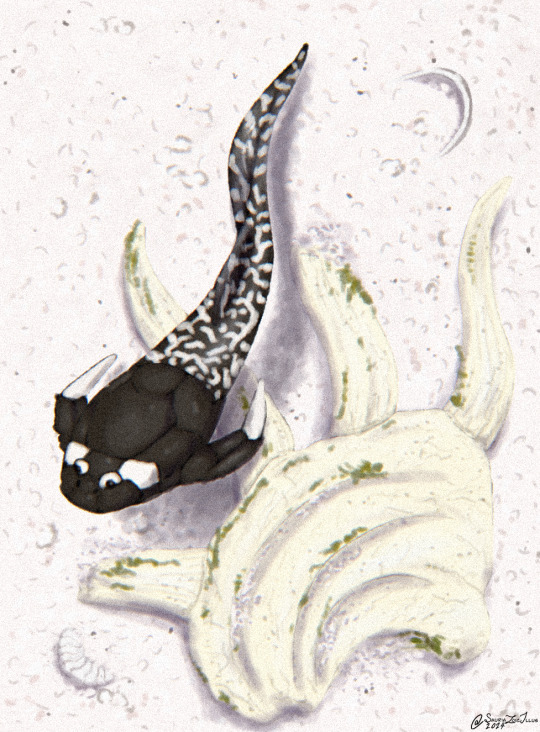


#Paleostream#sketch#sketches#paleoart#digital art#paleontology#digital artwork#artists on tumblr#palaeoart#digital illustration#sciart#id in alt text#paleoblr#palaeoblr#arthropod#invertebrate#crustacean#micrograph#Cambropachycope#fish#lobe finned fish#Onychodus#placoderm#Bothriolepis#squamate#mosasaur#mosasaurid#marine reptile#Xenodens#radiodont
104 notes
·
View notes
Text
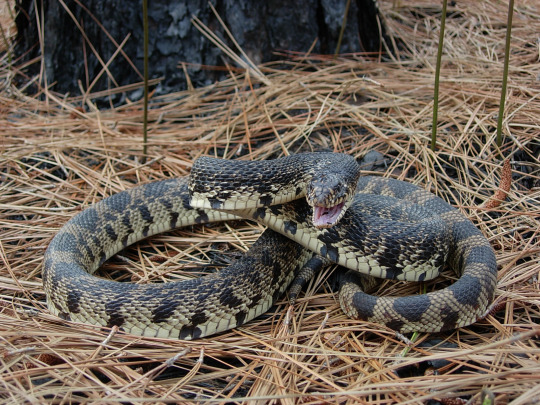
Louisiana Pine Snake (Pituophis ruthveni)
Family: Colubrid Snake Family (Colubridae)
IUCN Conservation Status: Endangered
Among North America's rarest snakes, the Louisiana Pine Snake's small population size is the result of its highly specific habitat requirements and the resulting sensitivity to human-driven habitat changes that comes with them; members of this species feed primarily on Baird's Pocket Gophers (a specific species of burrowing rodent,) and almost always live in abandoned Baird's Pocket Gopher burrows (often after having eaten the burrows creator,) and as such in areas where Baird's Pocket Gophers are not present Lousiana Pine Snakes cannot survive. Native to western Lousiana and eastern Texas, members of this species do best in pine forests (particularly those dominated by a specific species of pine, Pinus palustris, forests of which are noted to generally support high levels of biodiversity as a result of the loose canopies they form which allow many smaller species of plants to coexist with them,) and spend most of their lives underground, rarely travelling far from their stolen burrows. They emerge from their burrows mainly during the mid-day to hunt (targeting rabbits, frogs and other rodents when Baird's Pocket Gophers are scarce,) but otherwise remain concealed underground in order to avoid predation and unusually high or low temperatures; during the winter, when the weather becomes colder and prey becomes scarcer, they travel deeper into a Baird's Pocket Gopher burrow and hibernate until the early spring.
--------------------------------------------------------------------------
Image Source: https://www.inaturalist.org/taxa/29041-Pituophis-ruthveni
#Louisiana pine snake#snake#snakes#reptile#reptiles#zoology#biology#herpetology#animal#animals#herpetofauna#squamata#squamate#squamates#wildlife#North American wildlife#North American snakes
181 notes
·
View notes
Text
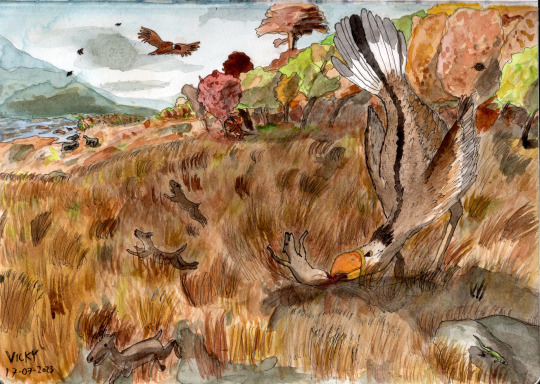
On the edge of a Miocene South American grassland, a group of Thoatherium is ambushed by a Phorusrhacos. They scatter, but the terror bird catches one of the litopterns, lifts it high up into the air, and SLAMS it down on the ground to kill it. Other nearby animals have mixed feelings about this situation. Tupinambis flees for its life, while Dryornis flies a little closer in case it can have a bit for itself. Hapalops and Astrapotherium are unbothered and have business of their own to take care of.
#phorusrhacos#thoatherium#terror bird#phorusrhacid#litoptern#cariamiform#bird#mammal#santa cruz formation#miocene#neogene#south america#autumn#tupinambis#lizard#squamate#dryornis#new world vulture#accipitriform#hapalops#ground sloth#pilosan#astrapotherium#astrapothere#my art#paleoart#palaeoblr#cw: animal death#cw: blood
78 notes
·
View notes
Text

Hisss
97 notes
·
View notes
Text

I got a visit from a local legend today!
This is Rustle, the Carpet Python. They're named so for the sound of rustling leaves they make as they move. Other that, people in the street usually know he's around by their shed skin. Actually seeing them is rare to my understanding, so I feel blessed. Interestingly, my mum was alerted to him by a local couple that were making alarm cries. When my parents were harrasing Rustle with photograph, the magpies were surprisingly tolerant of our presence while we were taking photographs. Maybe we made them feel safe?

Rustle resting in a tree, or perhaps hoping g to catch a bird feeding on Wattle necter.
#Carpet python#Coastal Carpet Python#Morelia spilota mcdowelii#python#snake#squamate#reptile#Australia#Australian wildlife
11 notes
·
View notes
Text
Fun fact: this genus of snakes survived the K-Pg extinction! They made it all the way to the Eocene, with possible finds going as far as the Miocene.


Madtsoia madagascariensis - the fossil 'madtsoiid' snake of Late Cretaceous Madagascar - constricting the theropod dinosaur Masiakasaurus knopfleri.
Prehistoric Planet 2 - Episode 1 - Islands
#masiakasaurus#madtsoia#snake#squamate#abelisaur#theropod#dinosaur#cretaceous#prehistoric planet#cw: animal death
156 notes
·
View notes
Text
Uncharismatic Fact of the Day
Open wide! The boomslang snake has one of the biggest mouths of any snake, capable of opening its jaws up to 170°! This is because boomslangs are opisthoglyphous, meaning that the fangs which deliver venom are farther back in their mouths- so to ensure their venom is properly delivered, they have to have a very big bite.

(Image: A boomslang snake (Dispholidus typus) bearing its fangs by Duncan Noakes)
#boomslang#Squamata#Colubridae#colubrids#colubrid snakes#snakes#serpentes#squamates#reptiles#uncharismatic facts
485 notes
·
View notes
Text
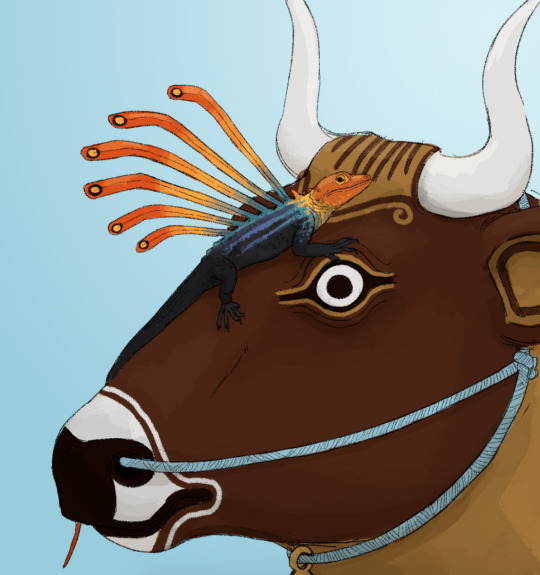
Fuck it, Longisquama analogue. Attempting to show himself off on a painted Ganmache cult statue.
#Not actually longisquama it's a squamate#I think it would be fun if Basically the same thing as one of the weirdest ancient reptiles was just out there as a completely#mundane sight. Common urban lizard#Probably part of a wider genera with most species in forest habitats and a few adapted to open grassland/scrub#creatures
431 notes
·
View notes
Text

Burning questions wanted!!
Tomorrow I'll be recording a new episode of the SquaMates podcast. So, now is your time: rebagel or comment with your burning herpetological questions you want myself and my co-hosts to answer on the show! Things we don't get to on this episode will be added to the list and we will try to get to them in the future!
100 notes
·
View notes
Text

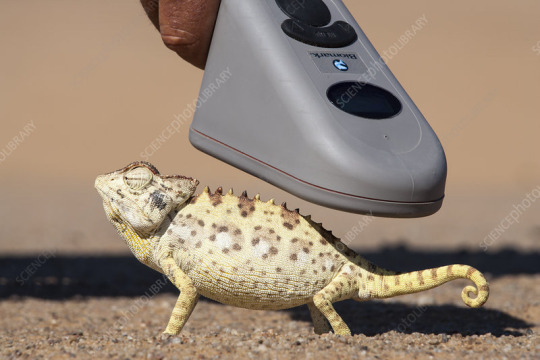
*beep beep* Yupp,as Suspected… “Lizartd.”
#silly#funny#196#rule#r/196#sillyposting#ruleposting#shitpost#shitposting#animalposting#animal memes#zoology memes#zoology#herpetology#lizard#chameleon#namaqua chameleon#squamates#reptiles#biology memes#my posts
876 notes
·
View notes
Note
blue tongued skink
Sure thing! I did one a while back but I'll do a different species this time.


Photos from Kelvin Marshall & John Sullivan respectively.
#blue tongued skink#common blue tongued skink#australia#indonesia#australian animal#indonesian animal#reptilia#reptile#reptiles#squamata#squamates#scincidae#skink#skinks#herpblr#animal polls#poll blog#my polls#animals#polls#tumblr polls
100 notes
·
View notes
Text
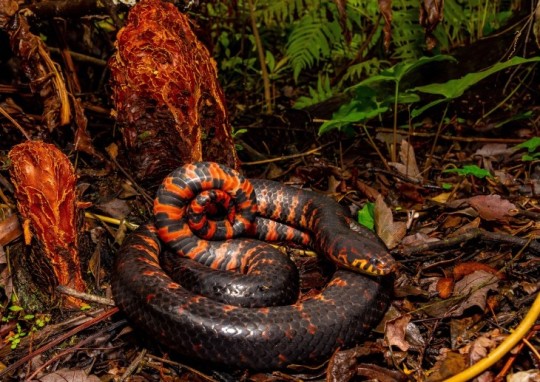
Mud Snake (Farancia abacura)
Family: Colubrid Family (Colubridae)
IUCN Conservation Status: Least Concern
Found mainly in rivers and swamps across much of the southeastern USA, the Mud Snake spends much of its life in the water, feeding primarily on large salamanders such as sirens and amphiumas and typically coming onto land only to bask, lay eggs or travel to other bodies of water during periods of drought. While they lack the venom that many aquatic snakes rely on to subdue prey, members of this species possess a large number of unusually long, curved teeth that aid them in catching slippery animals before swallowing them whole; when threatened they curl their bodies into tight coils and flash their striking red-striped bellies at perceived attackers, although as their teeth are made more for gripping than injuring and they lack venom, this is largely a bluff. Between October and November, when the weather in their native range becomes colder and their prey becomes scarcer, Mud Snakes enter a prolonged state of dormancy in muddy crevices or abandoned burrows, and after emerging again in the spring adults mate, with females laying clutches of over 100 eggs shortly afterwards, leaving them in wet, sheltered places where they will be kept warm and damp until they hatch roughly 60 days later.
--------------------------------------------------------------------------
Image Source: https://www.inaturalist.org/taxa/30106-Farancia-abacura
#mud snake#mudsnake#snake#snakes#zoology#biology#herpetology#animal#animals#wildlife#North American wildlife#herpetofauna#colubrid#reptile#reptiles#squamate#squamates
126 notes
·
View notes
Text
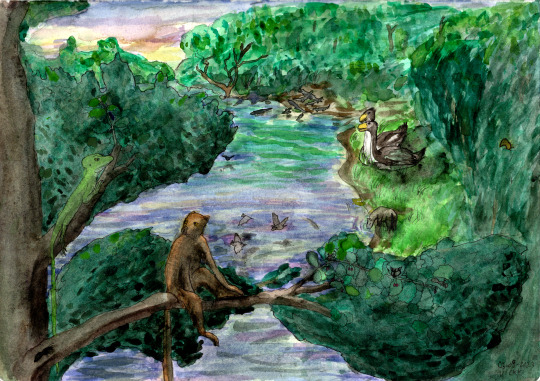
On a lovely evening 47 million years ago, Darwinius and Geiseltaliellus are forced to share their favourite lakeside tree. They do not particularly enjoy each other's company, but are unlikely to do something about it. Their tree has also become the grave of a couple of Titanomyrna infected with a cordycipitoid fungus, the giant ants spreading the fungus in their death grips. Meanwhile, a pair of Gastornis enjoys the evening Sun while a Eurohippus takes a drink, safe in the knowledge that these giant birds are herbivores. Archaeonycteris hunt insects above the lake, while various crocodylians hang out and get ready for the night.
#darwinius#geiseltaliellus#gastornis#eurohippus#titanomyrna#cordyceps#archaeonycteris#eocene#paleogene#paleoart#palaeoblr#my art#kopidodon#messel pit#adapiform#primate#mammal#corytophanid#lizard#squamate#bird#equid#perissodactyl#ant#insect#cw: bugs#cw: parasites#bat#crocodylian#i think that's everyone
59 notes
·
View notes
Text
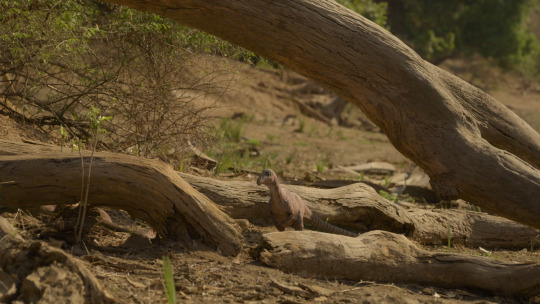
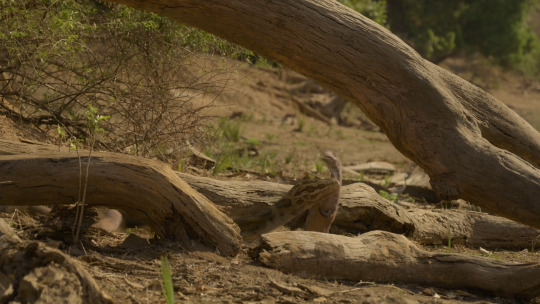


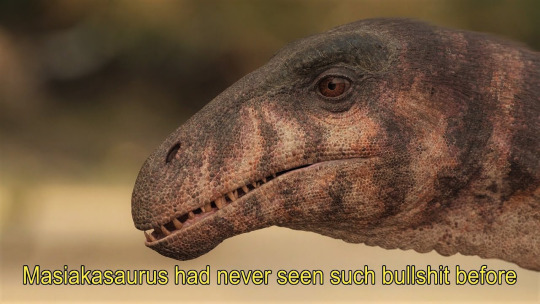
#masiakasaurus#abelisaur#theropod#dinosaur#prehistoric planet#coproliteposting#poor masiakasaurus#they need to watch out for ambush predators#madtsoia#snake#squamate#cw: snakes#in looking up this snake to get the spelling right i found out it survived the k-pg extinction!#they were around until the eocene#cw: animal death
30 notes
·
View notes
Note
Hiiiiiiiiiiiiiiiiiiiiiiiiiii!!!!!!!!!!!!!!!!!!!!!!!! what's the thingy on your profile pic? My guess is somesort of creeeeture within amber, correct? If so, what kind of creeeeeture is it? it's got a funky head it's pretty cool
Also I just remembered I can color text on the tumble so yeah I'm having fun with that hope you don't mind
HHHHHHHHHHOIIIIIIIIIIIIIIIII
Thr creature is a chameleon! I didn't have a species in mind but after some research I guess it's a mix of the big crown of the Veiled chameleon and the angled jaw of a Panther Chameleon to get the arrow shape.


Panther Chameleon Skeleton by Exifia on Deviant art.
There was a hubbub a few years ago about an amber specimen containing a chameleon, but that was later proved to be an Albernapid amphibian calked Yaksha by Susan E. Evans.

So a few things inspired it, like Jurrasic Park abd some amber related news at the time. But I think the main inspiration was the power and golden eggs from Splatoon.

This was unintentional but I think it's transformative enough to be okay.
The bean shape was inspired by the famous "gummy bear" amber fossil from Slupsk, Poland.
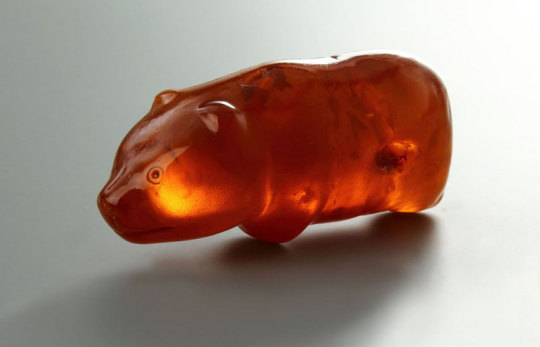
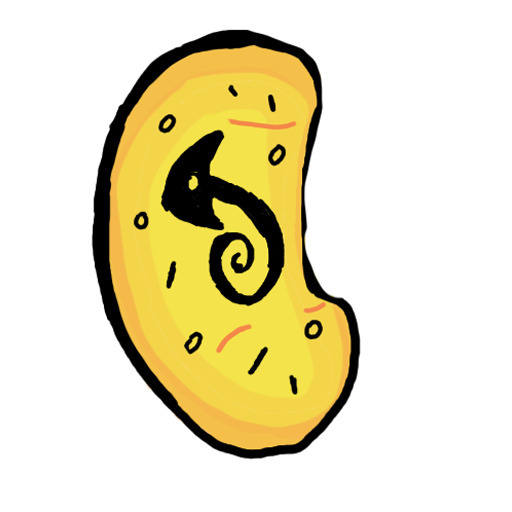
Sometimes, my mind conflates gummy bears and jelly beans lol.
Sorry if this is a bit rant-y, I try to keep track of where the inspiration for my art and designs comes from. I want to remake it at some point with cleaner lines and a better gradient, but I also like the more janky lines atm so we'll see when/if it happens.
Oh and I DON'T MIND THE COLOURS.
WWWHHHOOOOOOOOOOOOPPPPPP!!!!!!!
#Yaksha#Albenerpetid#Amphibian#Chameleon#veiled chameleon#panther chameleon#Squamate#amber#art#my art#gummy bean#profile picture#reptile
7 notes
·
View notes
Text
Sylus defo has two hemipenis… HEAR ME OUT! WAIT! the adventage of this is that they not only secrete sperm in one but the other release a fluid that… well… helps the mating plug stay in place after copulating… and… glues together the female mate’s genitalia after that too so other males can’t get in… HAHAHAHAH and uh… yeah…
It’s sooo different from a merman’s *cough* Rafayel *cough*.
- your friendly neighbor the monster biologist👹✌🏻
#tw monsterfucking#tw glued intimate parts#tw knotting#tw teratophilia#writing smut can be repetitive but when it comes to monsters is not like that HAHAJAHAHAHAAJHAA#there are no rules or guidelines HAHAHA have fun#but I thought this would help shape something more#omi.rambles#the more you know#HAHAHAHAH#I know this is a squamates thing and dragons aren’t reptiles per se buuuut I think it fits perfectly (pun intended)#dragons are defo a mix of species at the end of the day#and he’s a demon too so…#NO RULES AJAGAKBS#I just like writing monsters and hybrids#omi.thirst#tw dubcon
51 notes
·
View notes